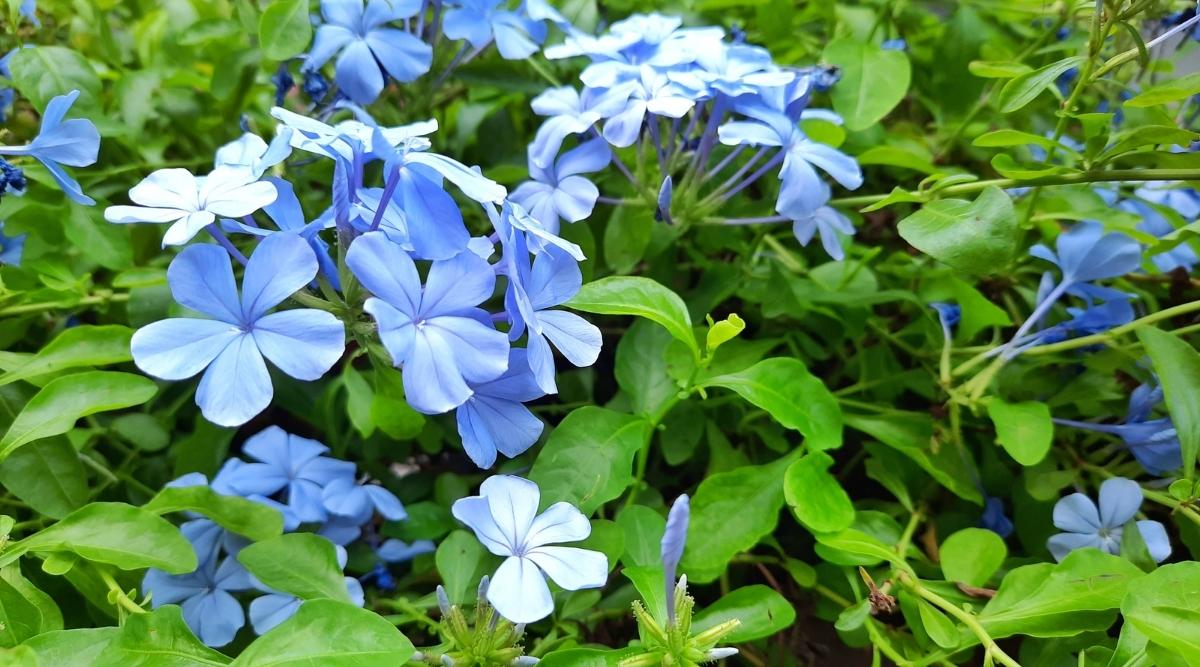journalofserviceclimatology.org – The Cape Leadwort (Plumbago auriculata), also known as Plumbago or Skyflower, is a charming, fast-growing shrub known for its delicate blue or white flowers that bloom profusely. Native to South Africa, Cape Leadwort has become a popular ornamental plant worldwide, particularly in warm, tropical, and subtropical regions. Its soft, cascading flowers and versatility make it a favorite for gardeners looking to add color, texture, and tropical flair to their landscapes.
Botanical Description
Cape Leadwort is an evergreen shrub that can grow up to 6 to 10 feet tall and just as wide, although it is easily pruned to maintain a smaller, bushy form. The plant’s branches tend to sprawl and climb if given support, allowing it to be trained as a vine or ground cover. Its leaves are small, green, and oval-shaped, providing a lovely contrast to the delicate flowers.
The standout feature of the Cape Leadwort is its beautiful clusters of five-petaled, tubular flowers that come in shades of light blue, sky blue, or sometimes pure white. The flowers bloom continuously from spring through fall, creating a long-lasting display of color that attracts butterflies and other pollinators. Their soft, sky-blue color is particularly rare among garden plants, making Cape Leadwort a prized addition for those seeking unique hues in their garden design.
Habitat and Growth Conditions
Cape Leadwort thrives in sunny, warm climates and is well-suited for USDA zones 9 to 11, where frost is rare or non-existent. It prefers full sun but can tolerate partial shade, although flowering may be reduced in lower light conditions. This plant grows best in well-drained, slightly acidic to neutral soil. It is tolerant of drought once established, making it a great choice for low-water gardens and Mediterranean landscapes.
In colder regions, Cape Leadwort can be grown in containers and brought indoors during winter. Its sprawling growth habit also makes it ideal for hanging baskets or window boxes, where its cascading flowers can trail over the sides.
Ecological Importance
As an ornamental plant, Cape Leadwort serves as an important nectar source for bees, butterflies, and other pollinators. Its long bloom season ensures that these beneficial insects have access to food throughout much of the year. While not native to many regions where it is cultivated, its non-invasive nature allows it to coexist well with native plants, adding beauty without disturbing local ecosystems.
Cultivation and Care
Cape Leadwort is a hardy and resilient plant that requires relatively little maintenance once established. It can be propagated from stem cuttings or planted from nursery-grown specimens. When planting, space the plants about 3 to 4 feet apart to allow for their spreading growth habit.
Water the plant regularly, especially during the first growing season, to help it establish a deep root system. Once mature, Cape Leadwort is drought-tolerant, though occasional deep watering during extended dry periods will keep it healthy and promote blooming.
Pruning is essential for maintaining the plant’s shape and encouraging bushier growth. Cape Leadwort responds well to hard pruning and can be cut back after flowering or during the winter months to maintain its size and shape. Fertilizing with a balanced, slow-release fertilizer in the spring will promote vigorous growth and abundant blooms.
Ornamental Uses
Cape Leadwort is highly versatile in the garden and can be used in a variety of ways. Its cascading growth makes it an ideal choice for ground covers, hanging baskets, or planting along retaining walls, where its flowers can trail gracefully. When planted near fences, trellises, or arbors, it can be trained to climb and create a living wall of blue or white blooms.
In addition to its use as a landscape plant, Cape Leadwort is also a popular choice for container gardens and balconies, where it can be brought indoors during cooler months in non-tropical regions. Its soft, colorful flowers add a tropical feel to patios, courtyards, and entryways.
Conclusion
With its graceful, sprawling habit and sky-blue flowers, Cape Leadwort is a must-have for gardeners looking to add a tropical touch to their outdoor spaces. Its low-maintenance nature, long-lasting blooms, and ability to attract pollinators make it a versatile and rewarding addition to a wide range of garden styles. Whether used as a ground cover, climbing plant, or container display, Cape Leadwort will delight with its beauty and resilience.
